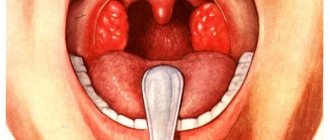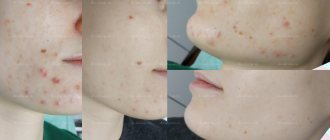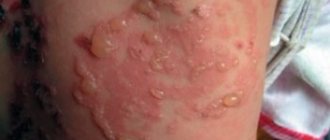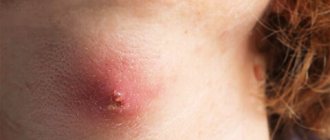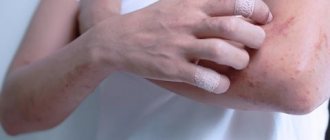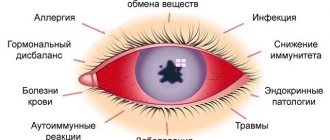Causes
Unlike ordinary sore throat, herpetic sore throat is caused by viruses. Among the main provocateurs, it is worth highlighting the Coxsackie virus type A or B, serovars, and ESNO viruses. They can be infected by droplets, fecal-oral routes, through bodily contact, and unprocessed food.
The pathogen, entering the body, multiplies in the intestines and lymph nodes. The pathogen spreads through the lymph and blood and intensively accumulates in the pharyngeal ring and tonsils. On the third day, the condition of the infected person deteriorates sharply.
Prevention
Viruses are very active. Once in the body of a healthy person, they quickly develop, and he, without even suspecting anything and visiting public places, becomes a carrier of the infection. Therefore, great importance is given to the prevention of herpetic sore throat. And it is quite possible to warn her.
Prevention measures:
- if there is a sick person in the family, he must be isolated;
- You should not visit shopping and entertainment complexes and hypermarkets during an outbreak of infections;
- it is important to wash your hands after going outside, public transport, shopping, etc.;
- thoroughly washing fruits and vegetables, purchasing dairy products only in specialized sealed packaging, and not at the market.
Symptoms
The following clinical picture appears sharply, acutely and violently:
- Within a few hours the temperature rises to 40°C.
- Chills and general weakness of the body appear.
- My head starts to hurt.
- When swallowing saliva or liquid, an unbearable sore throat develops.
- The color of the mucous membrane of the nasopharynx changes. After a few hours, the throat turns red, and the next day it becomes covered with many reddish blisters.
Acute symptoms last for 2-3 days, and then their intensity decreases.
Doctor Komarovsky's point of view
Since an effective antiviral drug that would help quickly cope with herpes sore throat has not yet been invented by scientists, Dr. Komarovsky is convinced that treatment should be carried out in three areas:
- reduce the concentration of the virus in the patient’s body;
- try to improve the condition of a sick baby;
- protect against the addition of any additional infection to the enterovirus.
Antipyretics, according to the pediatrician, can be given at temperatures above 38 degrees, as well as in the presence of alarming symptoms such as the appearance of seizures.
To improve the patient’s condition, it is necessary to temporarily abandon diapers, which impair the body’s thermoregulation, and excessive wrapping and tight swaddling. Drinking plenty of fluids is necessary.
As for medications, Komarovsky is very categorical; he is against the use of drugs in this situation to treat herpetic infections (such as Acyclovir and Gerpevir), although many of his colleagues do not rule out such treatment.
Symptoms of herpetic sore throat in children
Children attending nurseries or kindergartens, as well as schoolchildren, get sick most often. In children in the first three years of life, herpetic sore throat is extremely difficult, since the first signs of the disease are similar to the flu.
In addition to the general signs of intoxication, children appear:
- Temperatures up to 41°C.
- Pronounced hyperemia of the mucous membranes of the mouth and pharynx. During examination, the tissues appear to be filled with blood.
- A day later, 1-2 mm papules in the mouth, surrounded by a red rim. The next day they open, forming ulcers with crusts.
- Runny nose.
- Decreased appetite due to impossible pain.
- Enlarged lymph nodes located in the neck and ears.
If children have weak immunity, then sore throat occurs in waves, i.e. The deterioration of the condition is recorded after a few days, then it improves noticeably.
In addition, children experience stomach upset due to the fact that viruses irritate the mucous membrane of the digestive tract. The child complains of diarrhea and nausea.
How to treat infants and women during pregnancy
Experts think mainly theoretically about the danger of herpes sore throat for a pregnant woman and the fetus, since cases of the disease in expectant mothers are very rare, but if this happens, the disease usually proceeds easily, without consequences.
However, the description of the possible development of events suggests that the Coxsackie virus can overcome the placental barrier, therefore, in case of illness, a woman must be under the supervision of a doctor.
In the first weeks of pregnancy and in the first months after the birth of a child, a woman’s immunity is weakened, so contact of a pregnant and nursing mother with patients should be completely excluded.
If a woman does get sick, her sore throat lasts an average of 7-8 days, the doctor selects treatment. Is it possible to breastfeed the baby in this situation? In principle, yes, since the virus is not transmitted through breast milk .
However, a problem arises if a woman has to take any antiviral drugs, and hygiene requirements become more stringent.
In this regard, the question of whether it is possible to continue breastfeeding and how to do it safely for the baby is decided by the doctor.
This disease is very dangerous for infants. The diagnosis of herpes sore throat is usually a reason for hospitalization of the child.
In treatment, doctors use antibiotics, antipyretics, painkillers (Tantum Verde and the effective spray Ingalipt), and antihistamines.
This article discusses the main symptoms and treatment with photos of herpes zoster in humans. Find out more!
If you are interested in how to treat herpes on the lip during pregnancy safely and effectively, read our publication.
Diagnosis and treatment
At the appointment, the ENT doctor will examine the patient and conduct an examination. Based on the diagnostic results, drug therapy is prescribed, including:
- Taking antipyretics based on paracetamol or ibuprofen.
- Taking antiviral drugs prescribed after identifying the exact pathogen.
- Taking antihistamines. The active substance helps relieve swelling and ease breathing.
- Resorption of lozenges, lozenges, use of local sprays. Their antiseptic and bactericidal properties reduce sore throat.
- Local use of antiviral ointments based on interferon.
- Taking immunostimulants to activate the body's defenses to fight the pathogen.
It must be emphasized that antibiotics are powerless for this type of tonsillitis, because they do not affect the reproduction of viruses.
Important to remember! Do not apply heat compresses to the throat. Heating promotes the further spread of viruses throughout the body.
In addition to taking medications, the patient must be isolated from others and observe strict quarantine. The infectious period lasts two weeks. You need to follow a diet and eat pureed liquid food, drink more liquid. Water not only prevents dehydration, but also relieves symptoms of intoxication. If you are sick, you should not smoke, drink boiling water or water from the refrigerator.
Since the throat is constantly injured, healing occurs within 10-14 days. Crusts and sores are washed off with saliva without any residue.
It is important to know! Do not touch the bubbles with your hands or try to squeeze them out.
How is herpangina transmitted?
According to researchers from the Krasnoyarsk State Medical University, infection of children with enteroviral infections, including herpangina, often occurs in kindergartens, schools and summer camps. This most often occurs in summer and autumn, but can happen at any time of the year. The disease is transmitted by airborne droplets, that is, by inhaling particles of sputum or saliva of a patient (usually when he coughs or sneezes), and by contact with the feces of an infected person. Herpangina is extremely contagious, since enteroviruses remain viable outside the human body for a long time.
Signs of infection usually appear within 3-5 days after infection. An infected person is most contagious during the first two weeks, even if they show no symptoms of the disease. Parents can become infected from their child - however, many, after suffering herpetic sore throat in childhood, develop immunity to it.
Since children constantly touch everything around them and have little concern for personal hygiene, it is quite difficult to prevent the spread of herpangina. Make it a habit to thoroughly wash your hands and disinfect objects such as doorknobs and children's toys.
Specific features of herpetic sore throat
Herpetic tonsillitis can be distinguished from other types of sore throat by the following characteristics:
- A rash appears on the upper and lower extremities and face if not treated in a timely manner.
- Numerous red blisters appear on the pharynx, adenoids, tongue, and palate. Gradually they develop into ulcers and open. A light transparent exudate emerges from the bubbles. Typically there are from 5 to 20 ulcers in the mouth. If treatment is not started in time, the ulcers merge with each other, forming large areas of damage to the mucous membrane of the throat and mouth. In this case, there is a high risk of complications.
Often, parents mistake herpangina for another disease and try to cure it on their own. Herpetic sore throat should not be confused with:
- Thrush. Candidiasis in the mouth appears as a cheesy coating.
- Herpetic stomatitis. Papules are similar, but with stomatitis they are localized on the gums and tongue.
- Purulent sore throat. Formations accumulate only on the tonsils and lacunae, and with herpetic disease they cover the entire nasopharynx. In addition, a runny nose is a distinctive symptom. With purulent tonsillitis there is no runny nose.
Treatment with folk remedies
Traditional methods of treating herpetic sore throat can also be supplemented with folk remedies. But you should agree on the chosen prescription with your doctor. The most effective traditional medicine recipes are:
- Propolis. 2 grams of propolis should be chewed in the mouth for 15 minutes. The procedure must be repeated three times a day.
- Honeycomb can also be consumed as chewing gum three times a day.
- 1 teaspoon of aloe juice twice a day.
- Kalanchoe leaf will help cope with pain in the nasopharynx - you need to chew it until the juice stops secreting. Kalanchoe can be chewed three times a day.
- Propolis in the form of an alcohol tincture for gargling - dilute 1 teaspoon of solution in one glass of water.
Before using this or that folk remedy, you should make sure that the patient does not have allergies. Honey and propolis are fairly common allergens.
Complications
Unfortunately, this type of tonsillitis has dangerous negative consequences if the disease is started and left to chance. The greatest danger is from complications of the kidneys, brain and heart. Since the sore throat virus spreads through the flow of lymph and blood, inflammation can overtake certain parts of the brain, causing meningitis and encephalitis. Convulsions, persistent headache, increasing temperature are reasons to seek medical help again.
At the ENT CLINIC in Chertanovo, ENT doctors with extensive experience will carefully examine an adult and a small patient and immediately perform a serological and virological analysis to determine the causative agent. The technical equipment of our medical center allows us to obtain diagnostic results within a couple of hours. Thanks to this, therapeutic therapy is prescribed in a timely manner, with positive dynamics occurring the very next day.
Recommendations
At the first signs of discomfort, you should consult a doctor. If treatment is not started in a timely manner, serious complications may develop:
- meningitis with inflammation of the meninges;
- encephalitis (inflammation of brain tissue);
- hemorrhagic conjunctivitis - an infection of the eyes;
- rheumatism – connective tissues become inflamed;
- myocarditis is an inflammatory process in the heart muscle.
By following all the doctor’s recommendations and adhering to the course of treatment, you can avoid the development of these complications and significantly speed up the recovery process.
Process Features
“Almost every person has the herpes virus; it lives in the body, sleeps and waits in the wings. The hour comes when immunity decreases,” says the ENT doctor.
At the same time, he notes that the weather suitable for activation of the virus is dank, slushy, and frosty weather. Also, a person who has a dormant herpes virus can be negatively affected by the presence of a sick person next to him. If these three factors - decreased immunity for a number of reasons, inappropriate weather and the source of infection - come together, you can become familiar with the unpleasant manifestations of a sore throat.
“The herpetic infection enters through the mouth or nose and lingers in the area of the tonsils. Herpes plus this is present in the body in some quantity, as a result it becomes worse. In the case of ordinary sore throat, the causative agents are staphylococci and streptococci, but here there will be herpes, which means that the sore throat will already be viral and not bacterial,” notes the otorhinolaryngologist.
At the same time, as Vladimir Zaitsev says, there won’t be much difference in appearance, and such a disease can be recognized mainly by analysis.
Consequences of herpes. What can rashes on the lips cause? More details
